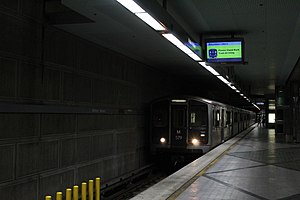 A train arrives at Wilshire and Western station | |||||||||||||
| General information | |||||||||||||
| Other names | Wilshire/Western/Alfred Hoyun Song | ||||||||||||
| Location | 3775 Wilshire Boulevard Los Angeles, California | ||||||||||||
| Coordinates | 34°03′42″N 118°18′33″W / 34.0617°N 118.3091°W | ||||||||||||
| Owned by | Los Angeles County Metropolitan Transportation Authority | ||||||||||||
| Platforms | 1 island platform | ||||||||||||
| Tracks | 2 | ||||||||||||
| Connections | |||||||||||||
| Construction | |||||||||||||
| Structure type | Underground | ||||||||||||
| Bicycle facilities | Metro Bike Share station,[1] racks and lockers[2] | ||||||||||||
| Accessible | Yes | ||||||||||||
| History | |||||||||||||
| Opened | July 13, 1996 | ||||||||||||
| Passengers | |||||||||||||
| FY 2024 | 2,460 (avg. wkdy boardings)[3] | ||||||||||||
| Services | |||||||||||||
| |||||||||||||
| |||||||||||||
| |||||||||||||
Wilshire/Western station is an underground rapid transit (known locally as a subway) station on the D Line of the Los Angeles Metro Rail system. It is located under Wilshire Boulevard at Western Avenue, after which the station is named, in the Mid-Wilshire and Koreatown districts of Los Angeles. It is the current western terminus of the D Line.
Prior plans called for the D Line to extend to Fairfax Avenue, then turn north into the San Fernando Valley but due to political disagreements, the line currently terminates here and the B Line travels to the Valley via Vermont Avenue.[4] Metro is now currently constructing the D Line Extension to extend the D Line west from this station to Westwood/VA Hospital station in Westwood, near UCLA.[5]
The two artwork installations at Wilshire/Western are called "People Coming", and the other "People Going". They are large murals at each end of the station. The artist responsible is Richard Wyatt, a Lynwood native.
The courtyard features a plaque commemorating former California Assemblymember Alfred H. Song and is officially named "Wilshire/Western/Alfred Hoyun Song station," although the full name is not used on any station signs.[6][7]
- ^ "Station Map". Metro Bike Share. 27 January 2015. Archived from the original on 2 January 2022. Retrieved November 13, 2021.
- ^ "Secure Bike Parking on Metro" (PDF). Los Angeles County Metropolitan Transportation Authority. Archived from the original (PDF) on September 6, 2021. Retrieved November 5, 2021.
- ^ "FY2024 Ridership by Station". misken67 via Los Angeles Metro Public Records. August 2024.
- ^ Elkind, Ethan N. (2014). Railtown: the Fight for the Los Angeles Metro Rail and the Future of the City. Berkeley. ISBN 978-0-520-95720-6. OCLC 868963746.
{{cite book}}: CS1 maint: location missing publisher (link) - ^ "Purple Line Extension". www.metro.net. Archived from the original on September 29, 2019. Retrieved March 2, 2020.
- ^ "Koreatown to install memorial for late Asian American politician". The Korea Times. September 10, 2014. Archived from the original on January 17, 2021.
- ^ "JoinCalifornia – Alfred H. Song". JoinCalifornia. Archived from the original on April 13, 2021.
